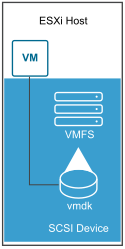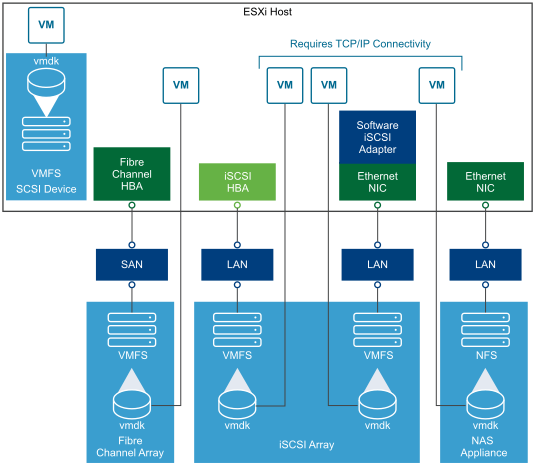In traditional storage environments, the ESXi storage management process starts with storage space that your storage administrator preallocates on different storage systems. ESXi supports local storage and networked storage.
Local Storage
Local storage can be internal hard disks located inside your ESXi host. It can also include external storage systems located outside and connected to the host directly through protocols such as SAS or SATA.
Local storage does not require a storage network to communicate with your host. You need a cable connected to the storage unit and, when required, a compatible HBA in your host.
The following illustration depicts a virtual machine using local SCSI storage.

In this example of a local storage topology, the ESXi host uses a single connection to a storage device. On that device, you can create a VMFS datastore, which you use to store virtual machine disk files.
Although this storage configuration is possible, it is not a best practice. Using single connections between storage devices and hosts creates single points of failure (SPOF) that can cause interruptions when a connection becomes unreliable or fails. However, because most of local storage devices do not support multiple connections, you cannot use multiple paths to access local storage.
ESXi supports various local storage devices, including SCSI, IDE, SATA, USB, SAS, flash, and NVMe devices.
Local storage does not support sharing across multiple hosts. Only one host has access to a datastore on a local storage device. As a result, although you can use local storage to create VMs, you cannot use VMware features that require shared storage, such as HA and vMotion.
However, if you use a cluster of hosts that have just local storage devices, you can implement vSAN. vSAN transforms local storage resources into software-defined shared storage. With vSAN, you can use features that require shared storage. For details, see the Administering VMware vSAN documentation.
Networked Storage
Networked storage consists of external storage systems that your ESXi host uses to store virtual machine files remotely. Typically, the host accesses these systems over a high-speed storage network.
Networked storage devices are shared. Datastores on networked storage devices can be accessed by multiple hosts concurrently. ESXi supports multiple networked storage technologies.
In addition to traditional networked storage that this topic covers, VMware supports virtualized shared storage, such as vSAN. vSAN transforms internal storage resources of your ESXi hosts into shared storage that provides such capabilities as High Availability and vMotion for virtual machines. For details, see the Administering VMware vSAN documentation.
Fibre Channel (FC)
Stores virtual machine files remotely on an FC storage area network (SAN). FC SAN is a specialized high-speed network that connects your hosts to high-performance storage devices. The network uses Fibre Channel protocol to transport SCSI or NVMe traffic from virtual machines to the FC SAN devices.
To connect to the FC SAN, your host should be equipped with Fibre Channel host bus adapters (HBAs). Unless you use Fibre Channel direct connect storage, you need Fibre Channel switches to route storage traffic. If your host contains FCoE (Fibre Channel over Ethernet) adapters, you can connect to your shared Fibre Channel devices by using an Ethernet network.
Fibre Channel Storage depicts virtual machines using Fibre Channel storage.

In this configuration, a host connects to a SAN fabric, which consists of Fibre Channel switches and storage arrays, using a Fibre Channel adapter. LUNs from a storage array become available to the host. You can access the LUNs and create datastores for your storage needs. The datastores use the VMFS format.
For specific information on setting up the Fibre Channel SAN, see Using ESXi with Fibre Channel SAN.
Internet SCSI (iSCSI)
Stores virtual machine files on remote iSCSI storage devices. iSCSI packages SCSI storage traffic into the TCP/IP protocol, so that it can travel through standard TCP/IP networks instead of the specialized FC network. With an iSCSI connection, your host serves as the initiator that communicates with a target, located in remote iSCSI storage systems.
ESXi offers the following types of iSCSI connections:
- Hardware iSCSI
- Your host connects to storage through a third-party adapter capable of offloading the iSCSI and network processing. Hardware adapters can be dependent and independent.
- Software iSCSI
- Your host uses a software-based iSCSI initiator in the VMkernel to connect to storage. With this type of iSCSI connection, your host needs only a standard network adapter for network connectivity.
You must configure iSCSI initiators for the host to access and display iSCSI storage devices.
iSCSI Storage depicts different types of iSCSI initiators.

In the left example, the host uses the hardware iSCSI adapter to connect to the iSCSI storage system.
In the right example, the host uses a software iSCSI adapter and an Ethernet NIC to connect to the iSCSI storage.
iSCSI storage devices from the storage system become available to the host. You can access the storage devices and create VMFS datastores for your storage needs.
For specific information on setting up the iSCSI SAN, see Using ESXi with iSCSI SAN.
Network-attached Storage (NAS)
Stores virtual machine files on remote file servers accessed over a standard TCP/IP network. The NFS client built into ESXi uses Network File System (NFS) protocol version 3 and 4.1 to communicate with the NAS/NFS servers. For network connectivity, the host requires a standard network adapter.
You can mount an NFS volume directly on the ESXi host. You then use the NFS datastore to store and manage virtual machines in the same way that you use the VMFS datastores.
NFS Storage depicts a virtual machine using the NFS datastore to store its files. In this configuration, the host connects to the NAS server, which stores the virtual disk files, through a regular network adapter.

For specific information on setting up NFS storage, see NFS Datastore Concepts and Operations in vSphere Environment.
Shared Serial Attached SCSI (SAS)
Stores virtual machines on direct-attached SAS storage systems that offer shared access to multiple hosts. This type of access permits multiple hosts to access the same VMFS datastore on a LUN.
NVMe over Fabrics Storage
VMware NVMe over Fabrics (NVMe-oF) provides a distance connectivity between a host and a target storage device on a shared storage array. VMware supports different technologies, including NVMe over RDMA (with RoCE v2 technology), NVMe over Fibre Channel, and NVMe over TCP/IP. For more information, see About VMware NVMe Storage.
Comparing Types of Storage
Whether certain vSphere functionality is supported might depend on the storage technology that you use.
The following table compares networked storage technologies that ESXi supports.
| Technology | Protocols | Transfers | Interface |
|---|---|---|---|
| Fibre Channel | FC/SCSI, FC/NVMe | Block access of data/LUN | FC HBA |
| Fibre Channel over Ethernet | FCoE/SCSI | Block access of data/LUN | Converged Network Adapter (hardware FCoE) |
| iSCSI | IP/SCSI | Block access of data/LUN |
|
| NAS | IP/NFS | File (no direct LUN access) | Network adapter |
The following table compares the vSphere features that different types of storage support.
| Storage Type | Boot VM | vMotion | Datastore | RDM | VM Cluster | VMware HA and DRS | Storage APIs - Data Protection |
|---|---|---|---|---|---|---|---|
| Local Storage | Yes | No | VMFS | No | Yes | No | Yes |
| Fibre Channel | Yes | Yes | VMFS | Yes | Yes | Yes | Yes |
| iSCSI | Yes | Yes | VMFS | Yes | Yes | Yes | Yes |
| NAS over NFS | Yes | Yes | NFS 3 and NFS 4.1 | No | No | Yes | Yes |
Target and Device Representations
In the ESXi context, the term target identifies a single storage unit that the host can access. The terms storage device and LUN describe a logical volume that represents storage space on a target. In the ESXi context, both terms also mean a storage volume that is presented to the host from a storage target and is available for formatting. Storage device and LUN are often used interchangeably.
Different storage vendors present the storage systems to ESXi hosts in different ways. Some vendors present a single target with multiple storage devices or LUNs on it, while others present multiple targets with one LUN each.

In this illustration, three LUNs are available in each configuration. In one case, the host connects to one target, but that target has three LUNs that can be used. Each LUN represents an individual storage volume. In the other example, the host detects three different targets, each having one LUN.
A device, or LUN, is identified by its UUID name. If a LUN is shared by multiple hosts, it must be presented to all hosts with the same UUID.
How Virtual Machines Access Storage
When a virtual machine communicates with its virtual disk stored on a datastore, it issues SCSI or NVMe commands. Because datastores can exist on various types of physical storage, these commands are encapsulated into other forms, depending on the protocol that the ESXi host uses to connect to a storage device.
Regardless of the type of storage device your host uses, the virtual disk always appears to the virtual machine as a mounted SCSI or NVMe device. The virtual disk hides a physical storage layer from the virtual machine’s operating system. This allows you to run operating systems that are not certified for specific storage equipment, such as SAN, inside the virtual machine.
The following graphic depicts five virtual machines using different types of storage to illustrate the differences between each type.
